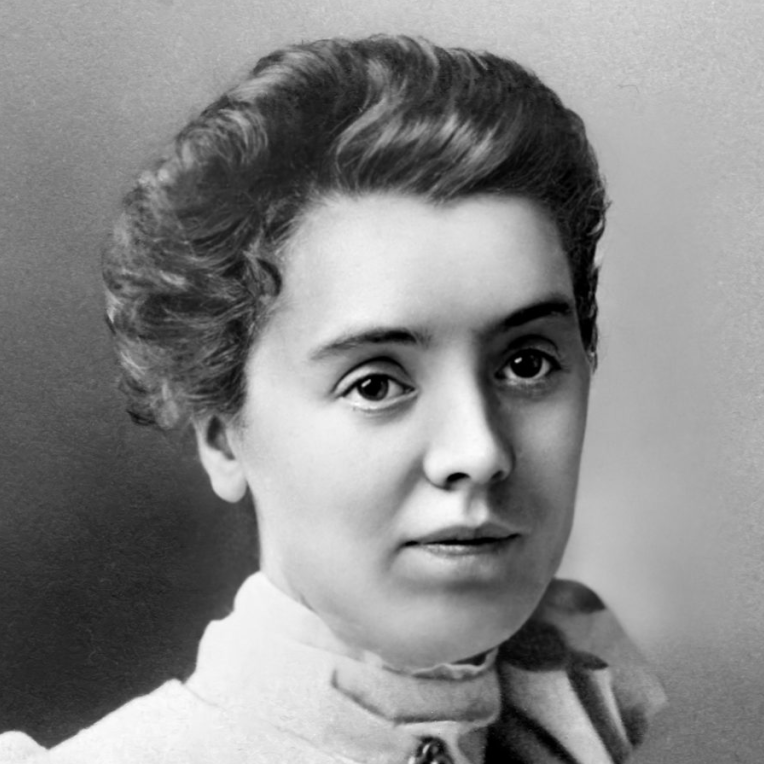
On 10 OCT 1877, my great-grandmother Elizabeth Gallacher was born in Dundee, Scotland to parents who were born in Scotland, and grandparents who were born in Ulster, Ireland. In the Scotland of her day, that made her Irish – not Scottish.
This is her history…
In Dumfriesshire and Galloway there are plenty of Irishmen ready to take the bread out of the mouths of our own poor. An Irishman who lives in a hovel, feeds on potatoes and neither clothes or educates his children, can always work for less than a Scot. There are too many people who employ only the cheapest workers and do not think of the consequences.
1845 Dumfries Courier
Elizabeth’s Grandparents
Armagh Flax Weavers
Elizabeth’s paternal grandfather was Charles Gallocher (Gollicher, Golachor, Gallagher, Gallacher), a flax weaver born in 1812 in Lurgan, County Armagh, Ireland. His father was John Gallocher who died in Lurgan sometime before 1838 – I know nothing else about him.
Her paternal grandmother was Elisabeth Whelan, born somewhere in Ireland in 1823. She was called ‘Betsy’ and her parents were James Whelan and Elisabeth Murphy, both farm workers.
On the 26 FEB 1838, Charles and Elisabeth married in Dundee, Scotland at the Roman Catholic Cathedral of St Andrew. It was a new church then, built in 1836 to serve the immigrant Irish.
The timing of their marriage tells us they were in Scotland at least a decade before the Irish famine – so that isn’t why they migrated. Charles’ hometown was a hub for linen manufacturing, as was the entire county of Forfar in Scotland – so they likely emigrated for work.
Given his age, Charles would have learned his craft as a hand weaver and watched the industrial revolution transform his trade. In 1841, when they were living at Arbroath, weaving was already mechanized but it was still powered by water. They lived in an area called Abbey Park, next to the ruins of a Benedictine Abbey. The whole area was dotted with mills and bleaching fields running adjacent to the river Brothhock Water.
By 1851, mills were coal powered and Scottish exports had shifted from textiles to iron and coal. The Gallochers were living on McKay Lane in Dundee, in an immigrant neighborhood called Deerhorn Close that was originally settled by Irish hand weavers but was now filled to the brim with millworkers. Don’t look for it, it’s long gone.
Charles died of long term heart disease at the age of 47 in 1859. Elisabeth was 36 at the time, and 7 of their 9 children were still living at home – the youngest just a toddler. To make ends meet, every child over the age of 10 worked in the mill. Later, when the children left home, Elisabeth took in borders. She survived him by 23 years, dying of bronchitis at the age of 59.
He was laid to rest in the New Burying Ground – also called the Constitution Road Cemetery. It was closed to new burials the year Elisabeth died and demolished in 1962 to make way for a parking lot. His remains would have been moved to a common plot at the Eastern Necropolis. I haven’t found any record of Elisabeth’s burial.









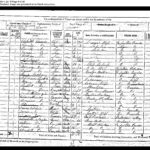

Antrim Iron Workers
Elizabeth’s maternal grandfather was Anthony Loughan (Logan, Lochan, Loughan, Loughlan) and he was born in 1823 on a farm in Stroan, Antrim, Ireland, about 3 miles from the town of Armoy.
His parents, my 4th great grandparents, were John Loughlan and Rose McCaughan and they had a leasehold on Lot 6, with some additional land on the upslope of Lot 2, totaling about 30 acres. That property stayed in the family from at least 1851 to 1929, and probably longer. But the lease was passed to Anthony’s older brother James, so any other siblings had to leave home.
Remember this farm, it will come up again later…
Anthony and his sister Mary Anne emigrated to Scotland. He worked as an iron miner and later became a foundry hammerman at Coatbridge, which is slightly east of Glasgow and connected to it by a canal.
The 1850 Catholic Directory described Coatbridge as “one vast mineral field. Every knowe has its own iron work or coal pit. The district is densely populated, chiefly by the humbler classes, almost all of whom are Irish immigrants.” Near the end of the Irish famine, 36% of its population was Irish and to this day, the Coatbridge accent is distinct from surrounding areas because of that.
He was living at Rosehall – a collier row outside of Coatbridge – when he married Mary Anne McAuley on 30 DEC 1849. She was born around 1831, definitely in Antrim, and maybe in the same parish as Anthony. Like Anthony, she was employed at the iron works, and continued working there even after 6 of her 10 children were born.
All of their children were baptized at the newly formed Roman Catholic church of St. Patrick’s, founded in 1848 to serve the immigrant Irish.
Anthony’s sister, Mary Anne Logan McGarry, was godmother to most of their children, and she pops up again and again. She married a widower with nearly grown children and didn’t have children herself – but repeatedly took in the children AND grandchildren of her two brothers.
I haven’t yet found a death record for either Anthony Logan or Mary Anne McCauley but I do know they must have died sometime between 1886 and 1900.

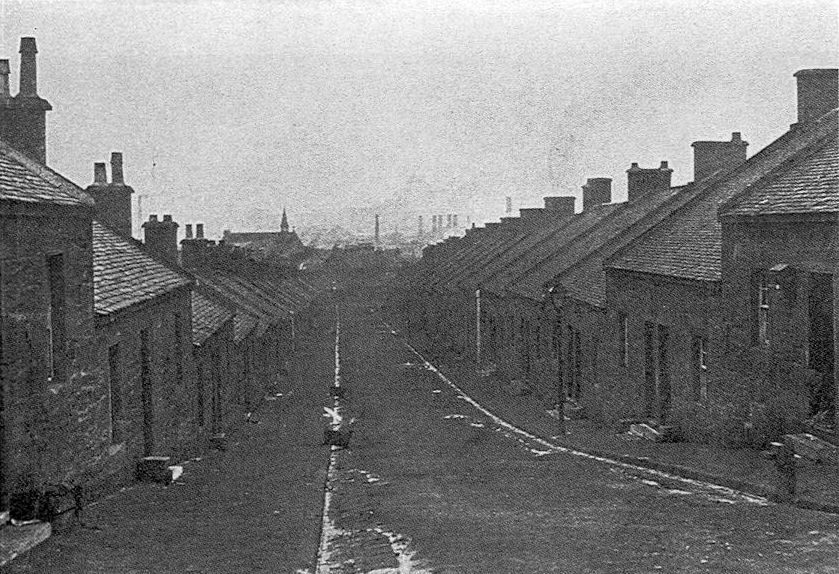
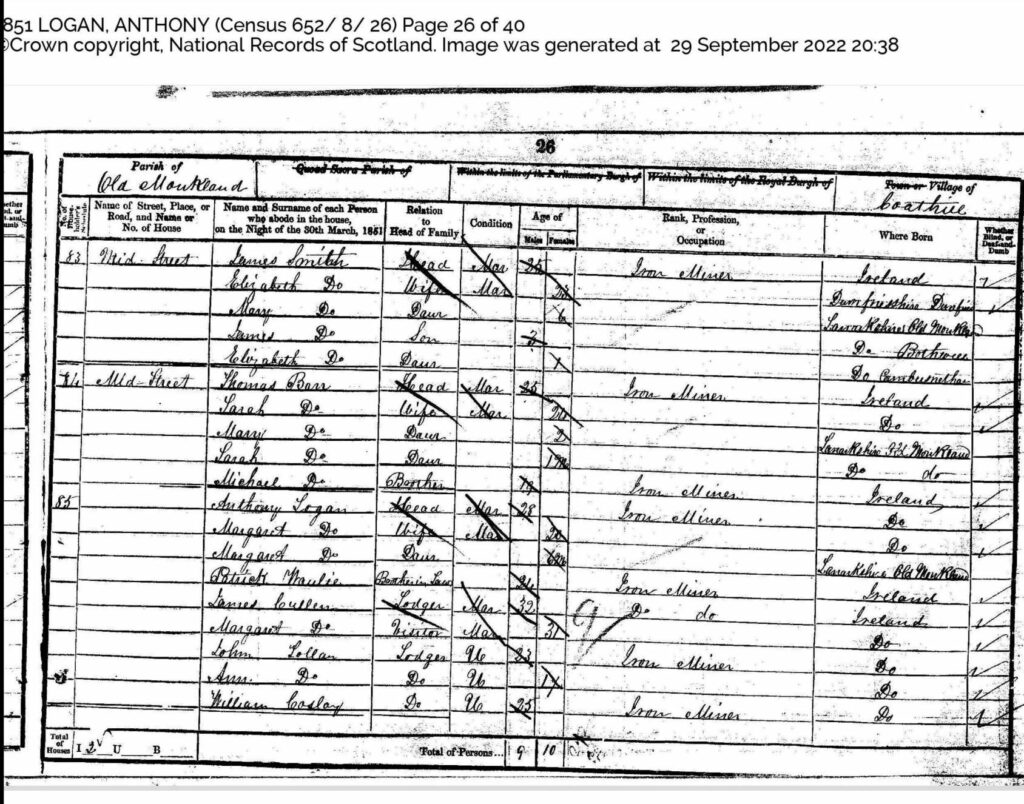



The immigration of such a number of people from the lowest class and with no education will have a bad effect on the population. So far, living among the Scots does not seem to have improved the Irish, but the native Scots who live in among the Irish have got worse. It is difficult to imagine the effect the Irish immigrants will have upon the morals and habits of the Scottish people.
1871 Scottish Census Report
Elizabeth’s Parents
Elizabeth’s mother, Harriet Logan, was born 6 JUL 1853 in Coatbridge, Scotland. She moved to Dundee to work in the mill sometime before the age of 17 and became a jute warper – that’s a mill worker who sets the warp yarn on a loom. Before her marriage, she was living with other single women, all of them millworkers, one of them just 10 years old.
Elizabeth’s father, Peter Gallacher (Golachor, Gollocher), was born in Dundee on 15 NOV 1852 and was baptized at St Andrew’s the day after Christmas. He was 6 years old when his father died of heart disease, and less than 19 when he left his mother’s house. He worked as a general labourer and then as a porter in the mill. For at least 10 years, he transported raw materials and finished textiles – eventually, becoming a foreman.
Harriet was 3 months pregnant on 3 NOV 1873 when they married at the chapel of St. Mary’s. That may be why she went home to Coatbridge to give birth to her first child, Alexander. He was left there for a while in the care of his great-aunt, Mary Anne Logan McGarry. Harriet’s other 7 children were all born in Dundee, but 2 of those would not live to adulthood.
In 1889, after years of working in the mill and moving around Dundee, the family put down roots at 16 Dundonald Street, opening a shop that sold sweets, tobacco and newspapers. They lived above the store and later offered room & board.
It may be that they opened the shop because of Peter’s poor health. He suffered a long time with pulmonary tuberculosis and it would have robbed him of the strength needed for millwork. He died 2 years after opening the shop, at the age of 39, passing away on his birthday in 1891. My great-grandmother Elizabeth reported his death to authorities. She was 14 and had 5 younger siblings at home. One of them would also die of TB within 4 years.
Harriet ran the shop until 1927, when she died at the age of 73 from colon cancer. Her youngest daughter carried on with it for 5 years. When she died in 1932, the shop closed doors after 51 years in business.




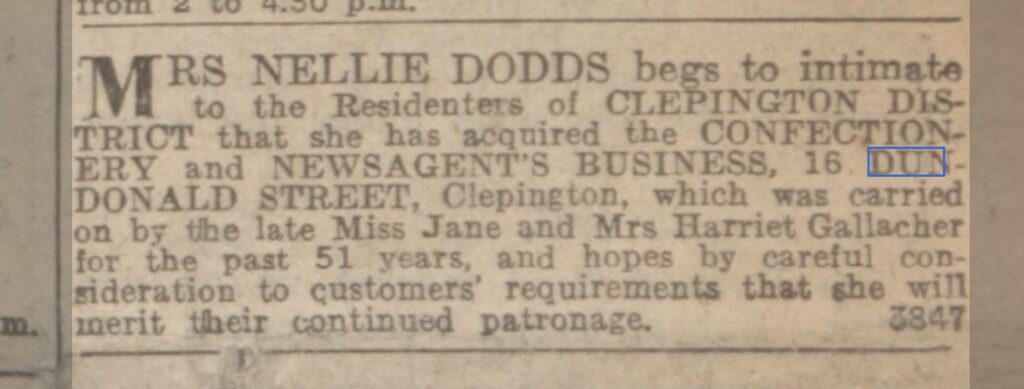


Elizabeth, the Emigrant
Elizabeth was the oldest child at home when her father died.
Her older brother, Alexander, had already left home and would have been 17 then. A few records suggest he was in America that year, but I’m not sure. His mother requested that the Cape Town and New York newspapers carry his father’s obituary, so maybe she wasn’t sure either. His naturalization papers say that he settled permanently in the US in 1896, at the age of 22. They also say his last place of residence was Mōkau, New Zealand. I know for certain he was a railroad engineer and a veteran of the Spanish-American War. I know that he lived in New York, started his family in Iowa, and settled down in Tampa, Florida. He died there at the age of 72, in 1946.
So Alexander was a rolling stone, but he was just the first. All of the Gallacher sisters would make their way to America – though not all of them would stay. My great-grandmother, Elizabeth, would emigrate 4x over the next 30 years – the first time in the wake of her father’s death.

Dundee, Scotland > Stroan, Ireland
Shortly after her father’s death, my great-grandmother was sent to live in Stroan, Ireland – on the farm where her grandfather Anthony was born.
Her grandfather had died by then, but his brother James was alive and still running the farm. He was nearly 50 when he married and lived to be 93. He had 3 children that I know of: Patrick, who would inherit the farm; Anthony, who sent to Scotland to live with his aunt Mary Anne Logan McGarry; and Maggie, who was on the farm as late as 1901, but gone by the time her brother inherited.
I don’t know much more about Elizabeth’s experience in Stroan except to say that she probably met her future husband there. Daniel Mullan was a rural postman in Armoy and service to Stroan – this farm included – was covered by his post office.
Stroan, Ireland > Boston, USA
On 14 OCT 1895, four days after her 18th birthday, Lizzie Gallacher left the city of Glasgow for Boston, traveling alone by steerage on the S.S. Scandinavian. There were two steamships of that name and this was the first. It still had sails.
Between the ship’s manifest and US immigration records, we know Lizzie was a winder – a skill she probably learned in the mills of Dundee as a child. We also know that her last residence was Stroan. She was literate, in good health, and had $2 in her pocket. She would be staying with her cousin Maggie Logan at 29 Water St. in Winchester, MA. This Maggie Logan – different from the cousin at Stroan – emigrated to Boston alone at the age of 19, just a year before Elizabeth.
My great-grandmother spent 5 years in Boston and worked as a maid in the home of Gertrude and Leonard Tufts at 149 Highland Ave, Medford, MA. Her employer was the son of a soda fountain magnate and he ran the family business while his father, James Walker Tufts, was developing the resort village of Pinehurst in North Carolina. The land was bought in 1895 and the first guests welcomed in 1901 – so Pinehurst was largely built while Elizabeth was living there, but she left before Leonard took over in 1902.
Elizabeth’s sister Mary Anne came to Boston in 1904, helped by the same cousin Maggie. Their sister Jane came in 1906, helped by Mary Anne. After less than a year, Jane left to run the family shop in Dundee and died there at the age of 44. Mary Anne left to get married in 1908, but came back again in 1912, when her husband died of tuberculosis. Eventually, she fell ill herself and died at the family home in Scotland on Dundonald St, aged 30.
The last Gallacher sister to come to America was the only one to stay put. Harriet’s fiancé John Clark found work in New Jersey and she followed him there. They married in 1906 and spent the rest of their lives in Metuchen. She died there in 1971.

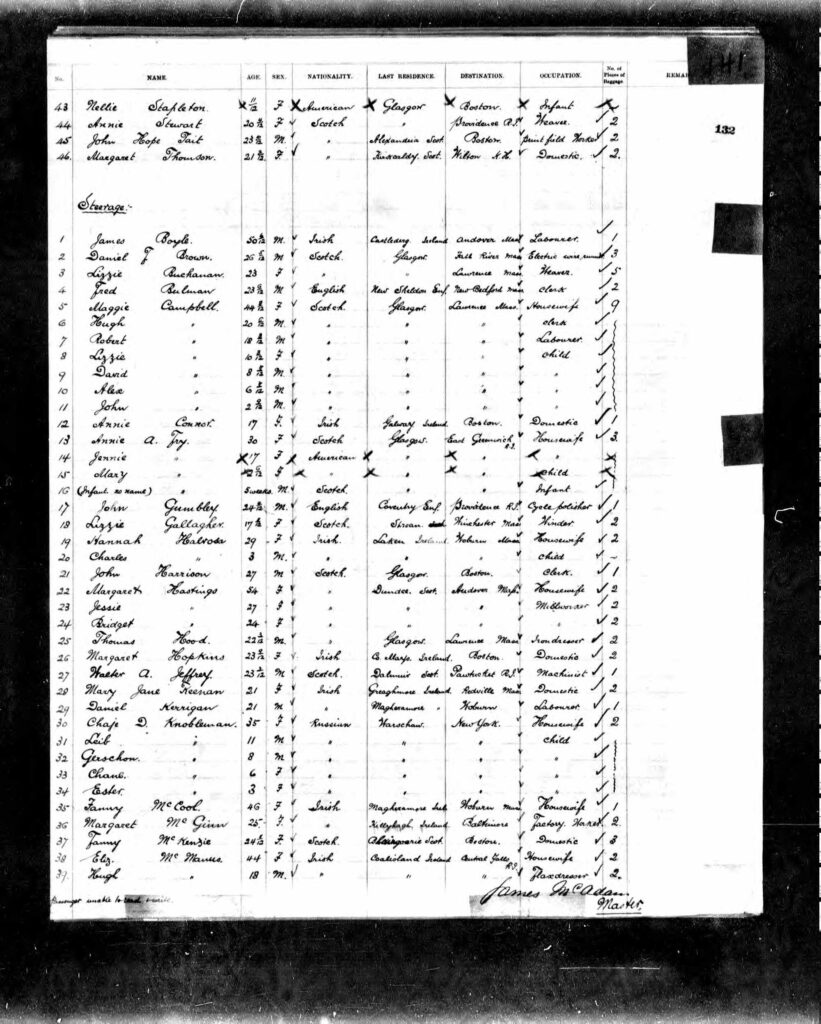

Boston, USA > Armoy, Belfast & Ballymoney, Ireland
Elizabeth Gallacher married Daniel William Mullan on 27 SEP 1900 at St. Joseph’s Church in the Sailortown neighborhood of Belfast. She was still in Boston in June when the US census was taken, so it looks as though they married when she got off the boat, and before heading back to Armoy.
I think it’s likely that they met when she lived at Stroan – because they would have shared a church, a post office and the same market town – but I can’t tell you if they were engaged before she left, or if they agreed to marry while she was away. We do have photos of them from around that time, so it seems likely that they corresponded. Whichever way it happened, they spent the next 9 years living in Armoy, and welcomed the first 3 of their 4 children there.
When her husband was promoted in 1909, the family moved to Thames Street in Belfast, a tiny semicircle just off the Falls Road. Their youngest child Harriet was born there and named for Elizabeth’s sister in Metuchen, NJ. By 1911, they left Belfast and settled in Ballymoney where they stayed for the next decade.
Britain was on the brink of conceding home rule at that time and protestants – fearing their minority status in an independent Ireland – signed the Ulster Covenant in 1912. When they assembled the Ulster Volunteers and began importing weapons, Catholics responded in kind.
The start of WWI delayed the outbreak of war at home, but only for a while. In the spring of 1916, the Easter Rising sharpened tensions and led to a gorilla war for independence between the IRA and the British forces. That war ended in 1921 with a treaty that recognized 26 counties as an independent Ireland, but left 6 counties, including Antrim, under British rule. A civil war followed between those who accepted partition and those who did not. That raged until 24 MAY 1923.
Elizabeth’s husband Daniel died of stomach cancer on 1 FEB 1923 – 4 months before of the end of the civil war. It must have been a terrifying time to have teenage sons. I once totaled all the Ballymoney men of service age who died in conflict that decade – it was a literal decimation. One out of every 10 men.
In MAY 1923, she sent her oldest son Daniel to America, and followed him 4 months later with the other children. They left from Londonderry on 27 SEP 1923 on the SS California, and headed not for Boston this time, but New Jersey – home of her married sister Harriet Gallacher Clarke.










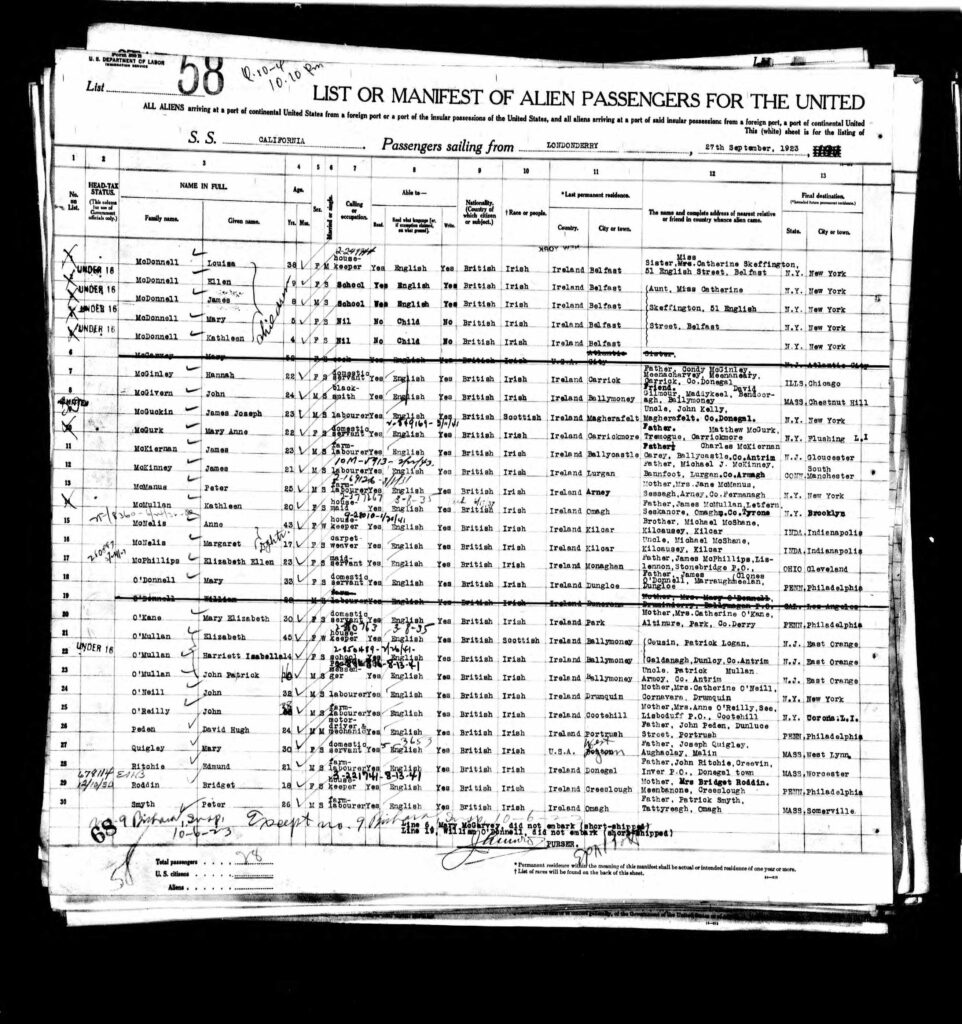
Ballymoney, Ireland > Orange, East Orange & Montclair, NJ
Elizabeth lived the rest of her life in New Jersey – keeping house for her adult children and working part-time as a housekeeper. She petitioned for US citizenship in 1931 and swore her oath of allegiance in 1938.
She passed away after a long illness, at the age of 80, on 5 DEC 1957. She spent her final years with her oldest daughter Elizabeth O’Mullan McAlister, and now rests in the McAlister family plot at Immaculate Conception Cemetery.
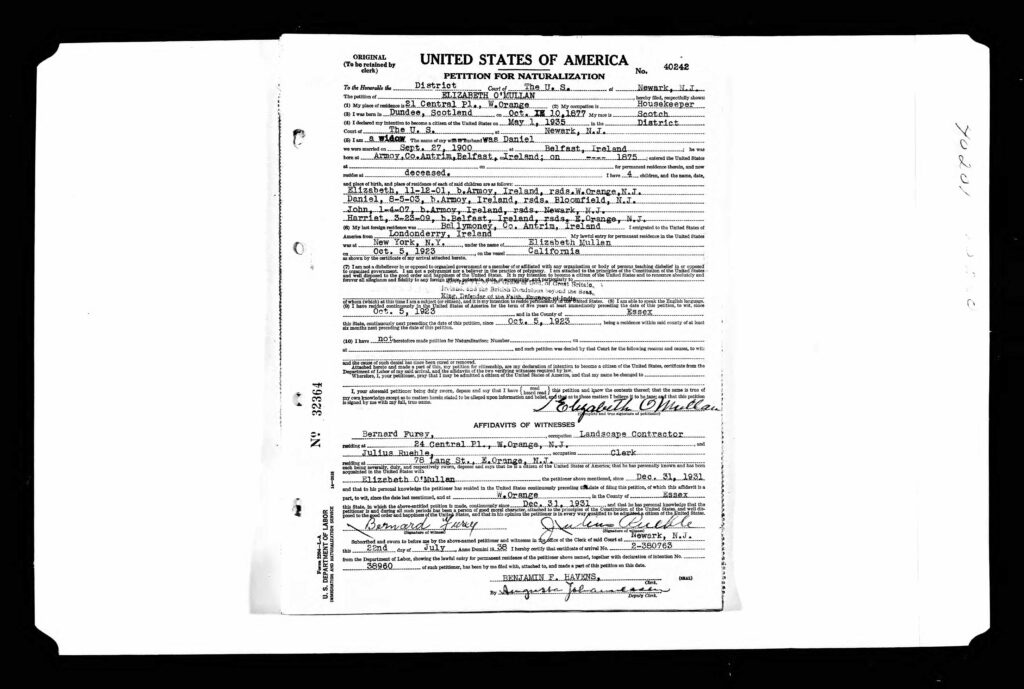





Footnote – so who gets to be Scottish?
The native population of Scotland were Picts, not Scots. The Romans built Hadrian’s Wall and the Antonine Wall to fence out the Picts, not Scots. Scots wouldn’t be in Scotland for another few hundred years.
The Scots came from Ulster and settled in western Scotland in the 5th century. For about 400 years, most of Ulster and western Scotland were part of a unified territory called Dál Riata. It was only in the 9th century that the Scots joined with the Picts – later rolling in the Lowland Scots (a Germanic people) and the Norse to form what you now think of as Scotland.
There was a lot of back and forth migration over the centuries and the proof is in Lizzie’s own surname – Gallacher. It’s an Irish word for a Scottish mercenary. The gallowglass were typically people of mixed Norse and Scots ancestry, and they were heavily recruited by Ulster nobles between the 13th and 16th centuries. They were paid in land and titles, intermarried, and used Gallagher or Gallacher as a surname. The original spelling was Gallchobhair, later Gallachóir, but it basically means ‘foreign helper’.
So her distant ancestors went to Scotland in the 5th century, came back to Ireland between the 13th and 16th centuries, returned to Scotland in the 19th century and were there for half a century when Elizabeth was born.
So was Elizabeth Scottish? She always thought so, and never claimed to be anything else. But, in the early 1900, her sisters listed their race as ‘Irish’ on US immigration forms.
